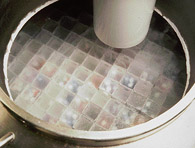
IVF embryo freezing
1983
'freeze-thaw' method for storing embryos
The miracle of human in-vitro fertilisation (usually shortened to IVF, it means growing embryos in glass lab containers from sperm and eggs) first happened in England in the late 1970s.
Researchers at Monash University and the Royal Women's Hospital in Melbourne went one step further. Led by Professor Carl Wood, the team perfected the equipment and procedures for IVF 'freeze-thaw' in 1983. They found that they had to take great care to exclude traces of contaminants from the fluid and glassware used to store the embryos, which are very sensitive to toxins.
The technique freezes numbers of in-vitro embryos, stores them, thaws them and then implants them into a woman at the best time for at least one of them to survive and grow into a baby. This procedure not only increases the chance of conceiving a baby, but also allows infertile couples to receive other couples? spare stored embryos.
The technique is expensive and controversial, and has probably caused more debate than any other medical procedure in modern history.
People are concerned about any unused embryos 'left in the freezer'. Are they alive? Who 'owns' them? What happens if the freezing apparatus breaks down? And who owns an embryo formed from the egg and sperm of one couple and transferred to another woman's body?
These questions will be discussed for many years to come.
Who Did It?
Key Organisations
Monash University : R&D
Queen Victoria Medical Centre : R&D
Royal Women's Hospital : R&D
Key People
Alan Trounson : team leader
Carl Wood : team leader
Further Reading
Babymaking: the technology and the ethics
Susan Downie
The Bodley Head, London, 1988, pp 161-179.
Links
Monash IVF
Professor Carl
Wood
|










